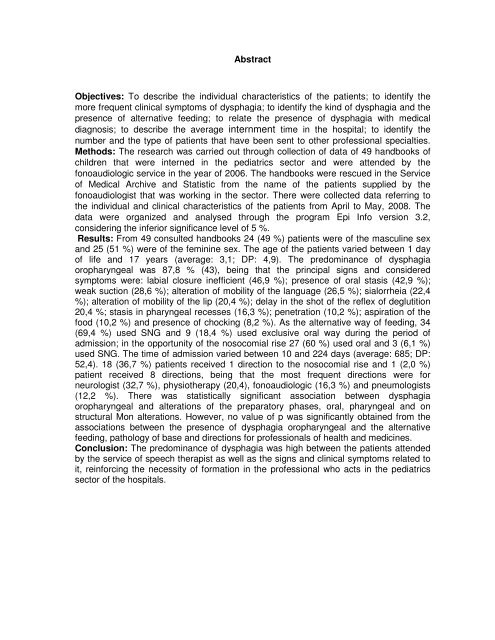Prevalência e características da disfagia em ... - StimuluSense
Prevalência e características da disfagia em ... - StimuluSense
Prevalência e características da disfagia em ... - StimuluSense
Create successful ePaper yourself
Turn your PDF publications into a flip-book with our unique Google optimized e-Paper software.
Abstract<br />
Objectives: To describe the individual characteristics of the patients; to identify the<br />
more frequent clinical symptoms of dysphagia; to identify the kind of dysphagia and the<br />
presence of alternative feeding; to relate the presence of dysphagia with medical<br />
diagnosis; to describe the average internment time in the hospital; to identify the<br />
number and the type of patients that have been sent to other professional specialties.<br />
Methods: The research was carried out through collection of <strong>da</strong>ta of 49 handbooks of<br />
children that were interned in the pediatrics sector and were attended by the<br />
fonoaudiologic service in the year of 2006. The handbooks were rescued in the Service<br />
of Medical Archive and Statistic from the name of the patients supplied by the<br />
fonoaudiologist that was working in the sector. There were collected <strong>da</strong>ta referring to<br />
the individual and clinical characteristics of the patients from April to May, 2008. The<br />
<strong>da</strong>ta were organized and analysed through the program Epi Info version 3.2,<br />
considering the inferior significance level of 5 %.<br />
Results: From 49 consulted handbooks 24 (49 %) patients were of the masculine sex<br />
and 25 (51 %) were of the f<strong>em</strong>inine sex. The age of the patients varied between 1 <strong>da</strong>y<br />
of life and 17 years (average: 3,1; DP: 4,9). The predominance of dysphagia<br />
oropharyngeal was 87,8 % (43), being that the principal signs and considered<br />
symptoms were: labial closure inefficient (46,9 %); presence of oral stasis (42,9 %);<br />
weak suction (28,6 %); alteration of mobility of the language (26,5 %); sialorrheia (22,4<br />
%); alteration of mobility of the lip (20,4 %); delay in the shot of the reflex of deglutition<br />
20,4 %; stasis in pharyngeal recesses (16,3 %); penetration (10,2 %); aspiration of the<br />
food (10,2 %) and presence of chocking (8,2 %). As the alternative way of feeding, 34<br />
(69,4 %) used SNG and 9 (18,4 %) used exclusive oral way during the period of<br />
admission; in the opportunity of the nosocomial rise 27 (60 %) used oral and 3 (6,1 %)<br />
used SNG. The time of admission varied between 10 and 224 <strong>da</strong>ys (average: 685; DP:<br />
52,4). 18 (36,7 %) patients received 1 direction to the nosocomial rise and 1 (2,0 %)<br />
patient received 8 directions, being that the most frequent directions were for<br />
neurologist (32,7 %), physiotherapy (20,4), fonoaudiologic (16,3 %) and pneumologists<br />
(12,2 %). There was statistically significant association between dysphagia<br />
oropharyngeal and alterations of the preparatory phases, oral, pharyngeal and on<br />
structural Mon alterations. However, no value of p was significantly obtained from the<br />
associations between the presence of dysphagia oropharyngeal and the alternative<br />
feeding, pathology of base and directions for professionals of health and medicines.<br />
Conclusion: The predominance of dysphagia was high between the patients attended<br />
by the service of speech therapist as well as the signs and clinical symptoms related to<br />
it, reinforcing the necessity of formation in the professional who acts in the pediatrics<br />
sector of the hospitals.


